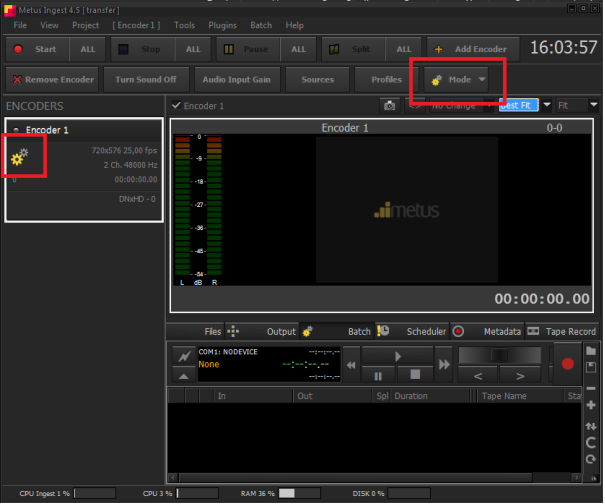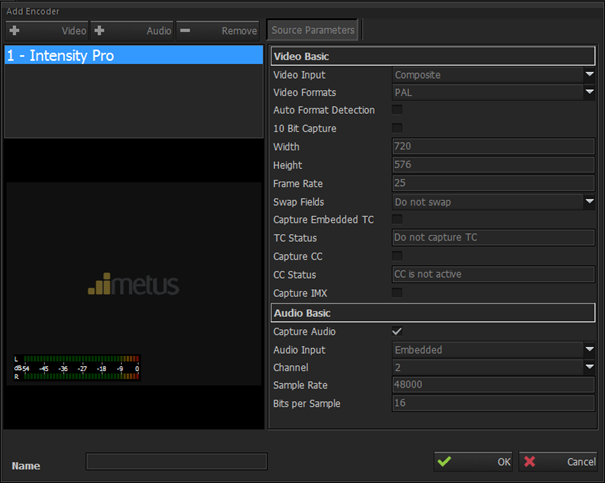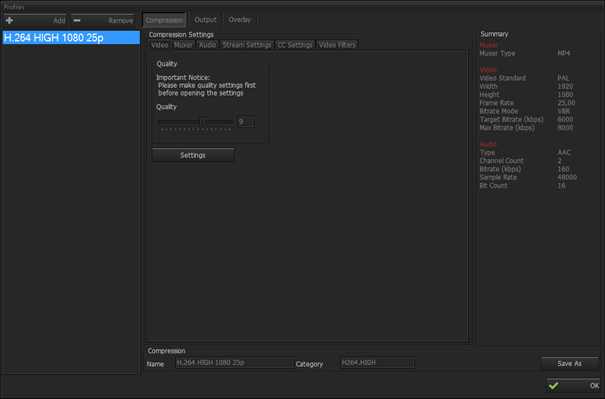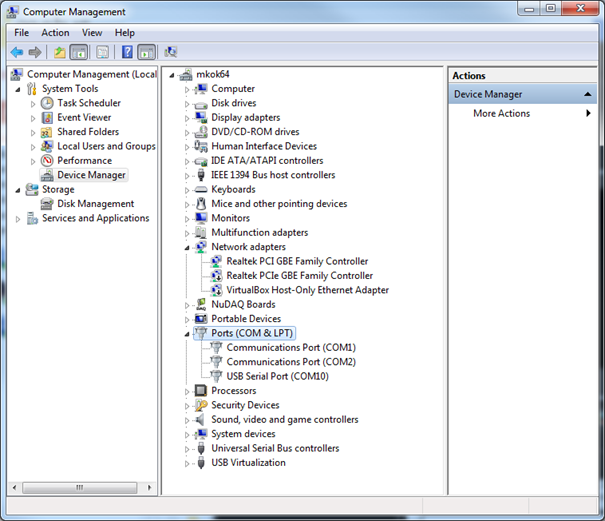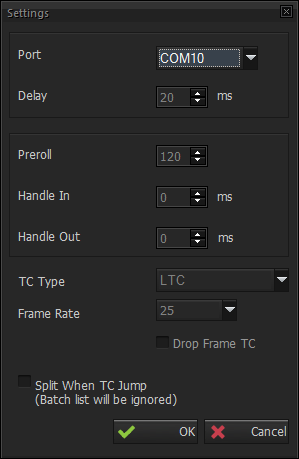Batch Capture Mode - The Latest
Batch:You need to set recording mode to Batch option if you want to enable batch recording from VTR, DVCAM, etc. devices. It is shown below choosing Batch Capture Mode and its appearance on the Left Panel after choosing Batch Capture Mode .
Batch Capture from VTR, DVCAM
Metus Ingest can record from the tape recorders and VTRs which can be controlled via RS422 interface using the batch capture feature.
Capturing with Batch Capture:
1. Attach the tape source to your computer via its RS422 remote control port.
2. Run Metus Ingest, add an encoder and select the source.
3. Select the profile(s) you wish to add from Profiles Window.
4. Change Mode to Batch.
5. Click to Batch window to set the parameters for batch recording.
6. On the display shown on the left corner of the figure above, no device (VTR) has yet connected to the Ingest, so the user should check com port settings from Computer Management => Device Manager=> Ports. On the figure shown below, an USB external COM port device has been installed as COM10.
Therefore the user should change Port setting to COM10 by clicking to Settings button
After the user changes com port from Settings , the name of the VTR (PVW2600) connected to COM10 appears on the batch display.
7. Click Play button to watch the source.
8. By clicking to “” button a new batch capture task can be added. Then In, Out times, File Name, Folder and Tape Name values are set.
On the figure shown below, In and Out points are set by the user, so the time difference. Duration, is automatically set. If the user leaves File Name and Folder as <Use Profile Settings>, then the values are automatically retrieved from the Output tab of the Profile window. The user can optionally set the name of the tape. If the Tape Name value is set, application prompts and waits for the appropriate tape is inserted into the VTR.
9. The user can start to record by clicking the big red dot on the right corner of the Batch window. During recording, the record button turns from red to black and Status changes to “positioning” tehn to “capturing”.
Batch Window
This window is at the bottom panel.
Batch buttons are described as below;
Lock
Start / Stop batch capture.
Import:It imports the saved list to the Progress List.
Export:It exports the list as text file.
Add
Remove
Sort
Clean
Reset:clears Status in the List.
Ping:refreshes the connection between VTR and the computer.
Settings:it sets the connection parameters between VTR and the computer.
Connect: Tries to re-connect to the VTR if the connection is broken.
Eject: Ejects the cassette in the tape source.
Play : Starts to play the cassette
Pause:Pauses the cassette.
Stop:stops all actions like playing, rewinding, forwarding, capturing.
FF:forwards the media
Rewind:rewinds the media
Next Frame: forwards the media 1 frame.
Previous Frame:rewinds the media 1 frame.
Jog: Forwards or rewinds the cassette.
Go: Seeks to an exact time code.
GO button on the Batch window.
Mark In: Sets the current position as the In value for the selected batch item.
Mark Out: Sets the current position as the In value for the selected batch item.
Standby: switches VTR between STANDBY ON and STANDBY OFF modes when VTR is in STOP mode. In STANDBY ON mode, the head drum is rotating and the tape keeps wound on the drum under tension. In STANDBY OFF mode, the tape is released from tension going out of contact with the head drum, which is now stopped from rotating. The purpose of this mode is protect the tape from fatigue and wear.
On the figure shown above, the area colored with orange shows the status of the recording. The status and the colors of the area are;
- complete >> green
- positioning >> yellow
- capturing >> orange
- aborted >> red
For the recording to be done, the checkbox must be checked.
In is the start time of the recording,
Out is the end time of the recording,
Spl; if the user wants to create seperate files for each recording, this option should be selected.
On the above sample, two files wil be created as a result of the batch capture. After the first item, encoder will split and so a new file will be created. Item 2 and 3 will be recorded without split so they will be recorded to the second file.
Note: If the user enables splitting from Profiles by checking Record Limitation from Profiles, Output tab on the Ingest, then there is no effect of splitting from Batch window.
File Name is the name of the file with the result of the recording.
Folder is the folder name of the resulted file.
Tape Name (optional) is the name of the source.
Status is the phase of the recording.
Settings
Port: should be set to any serial port (COM1 or COM3) to connect VTR to the computer that Ingest application runs.
Delay: the frequency (in ms) of the port scanning between VTR and the computer.
Preroll: the VTR playback is started from the number of frames earlier then the record “In” position to get a stable video out when the record In position is reached. This value can be maximum 250 frames.
Handle In: the recording starts as early as the value entered in this field.
Handle Out: the recording stops as later as the value entred in this field.
TC Type: The type of TC signal that will be read from the VTR. It can be LTC, VITC or CTL.
If the user doesn’t want to lose a frame from the beginning or at the end of the record, Handle In and Handle Out values must be set from the Settings window. The value in Handle In field defines the time value that how early the recording will start. The value in Handle Out field defines the time value that how later the recording will stop.
Use Encoder TC Value for Capture: Encoder TC can be used for batch capture if source contains TC and provides frame accurate capture.
The Format of the Saved List
The format of the imported list is shown below, (;) character should be put among the parameters in the list.
The minimum number of the parameters are shown on the figure below, In and Out parameters should be defined and (;) character should be inserted for the null parameters.
